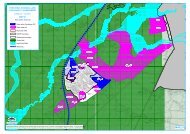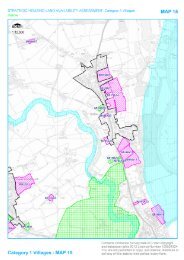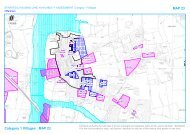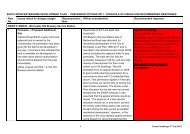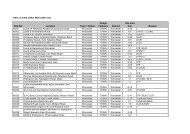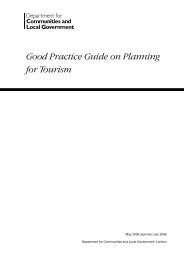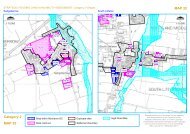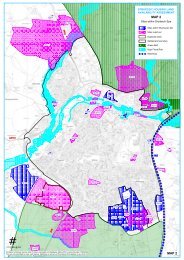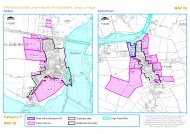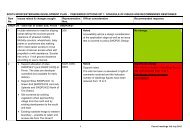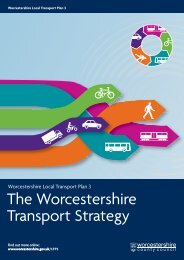Strategic Flood Risk Assessment - South Worcestershire ...
Strategic Flood Risk Assessment - South Worcestershire ...
Strategic Flood Risk Assessment - South Worcestershire ...
Create successful ePaper yourself
Turn your PDF publications into a flip-book with our unique Google optimized e-Paper software.
The ability to manage flood risk for new development must consider a wide range of issues,which includes how any evacuation of the occupants would be handled, how the newdevelopment fits in with the existing flood management provision and, should there be an event,how quickly the wider area would recover and return to normal. Some areas, either throughnatural or artificial topography, are easier to integrate flood management measures into the newdevelopment, without causing a significant alteration in its design and its place setting. Thesemeasures can have the potential to cause an alteration to the flood risk to adjacent property or inflood cells on the opposite bank.5.4 Sequential TestThe Sequential Test must be performed when considering the placement of future developmentand for planning application proposals. The NPPF Technical Guidance gives detailedinstructions on how to perform the test. These instructions on how to perform the test should beused with the following information from the SFRA:Identify the area to be assessed (including alternatives) on the <strong>Flood</strong> Zone Maps that areprovided with this assessment;Establish the risk of flooding from other sources again using the Maps in this SFRA; andFollow the instructions given in the Technical Guidance.The Sequential Test is used to direct all new development (through the site allocation process) tolocations at least risk of flooding, giving highest priority to <strong>Flood</strong> Zone 1. MHDC, WDC and WCChave sequentially tested the development sites in the SWDP.The Level 2 SFRA provides further flood risk evidence which the councils can use to assesswhether it is necessary to revisit/update the Sequential Test. The Environment Agency (2009) 12recommends that the following approach is used by local planning authorities to apply theSequential Test to planning applications located in <strong>Flood</strong> Zones 2 or 3. There are three stagesto the test, as follows:Stage 1 – <strong>Strategic</strong> application & development vulnerabilityStage 2 – Defining the evidence baseStage 3 – Applying the Sequential TestStage 1 – <strong>Strategic</strong> Application & Development VulnerabilityThe Sequential Test can be considered adequately demonstrated if both of thefollowing criteria are met:The Sequential Test has already been carried out for the site (for the samedevelopment type) at the strategic level (development plan) in line withprocedures agreed within the National Planning Policy Framework; andThe development vulnerability is appropriate to the <strong>Flood</strong> Zone (see Table 3 ofNPPF Technical Guidance)1.1 Has the Sequential Test already been carried out for this development at thedevelopment plan level? If yes, reference should be provided to the site allocation andDevelopment Plan Document (DPD) in question.1.2 Is the flood risk vulnerability classification of the proposal appropriate to the <strong>Flood</strong>Zone in which the site is located according to Tables 1 and 3 of the NPPF TechnicalGuidance? The vulnerability of the development should be clearly stated.Finish here if the answer is ‘Yes’ to both questions 1.1 and 1.2.Only complete Stages 2 and 3 if the answer to either questions 1.1 and 1.2 is ‘No’.12 Environment Agency (2009) Demonstrating the flood risk (PPS25) Sequential Test for Planning Applications, PPS25FRSA (national) version 2.0 Advise issued on 27 January 20092012s5947 S <strong>Worcestershire</strong> Level 2 SFRA Update FINAL Report v1.0.doc 30




